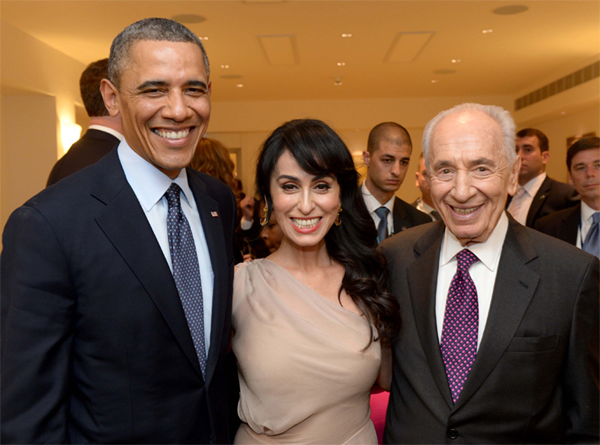January 03-2014

Rita Jahan-Foruz, unquestionably Israel’s most popular female singer, insists there is “no quarrel” between the people of Israel and the people of Iran and says, “I am very Iranian and very Israeli.”
During an interview with CNN’s Christiane Amanpour last month, the singer, who was born in Iran but moved to Israel at the age of eight, said the issue is “between the government or the leaders or something like that.”
“I am very Iranian and very Israeli,” she said. “I can show that everything can intertwine amazingly.”
Known throughout Israel simply as “Rita,” the 51-year-old’s latest album is in Persian, but before that she released all her albums in Hebrew or English. The latest album has made it clear to her fans what many did not know before—that she is Persian through and through.

She says she chose to sing in Persian to break down the “wall” between Israelis and Iranians, or at least make some “scratches and small holes.”
Her albums sell under the table in Iran where she understands she has many fans. She described fan emails she had received from Iranians who enjoy her music.
One fan, she said, sent her a “cute” email saying that he wanted to see her concert so badly that the punishment of three years in prison and 70 lashes for going to Israel would be worth it.
She says the difference in culture between the two nations is extreme. “The Iranian mentality is covered layer by layer, revealing some, but keeping most hidden.” She was surprised when she moved to Israel and found a “free, open, cheeky, immediate” mentality.
“I thought they were all crazy because they were so free.”
Rita made a North American tour last November shortly after her Persian album was released and packed the six concert sites largely with a combination of Jews and Iranians.
Rita had sung for a quarter of a century in Hebrew and English. But her 2012 album, which has sold like hotcakes in Israel, is sung entirely in Farsi. Many around her questioned her decision to advertise her ethnicity just when Iranian-Israeli relations had hit a new low. But the album has been astonishingly successful and Israelis very receptive.
Rita said, “I want to introduce the world to the real and immensely rich Iranian culture. Extreme regimes are so temporary compared to the eternal and endless richness found in Iranian culture…. In my personal, musical way, I want to introduce the world to its real face as much as I can.”
The tunes in the album, titled “My Joys,” are mostly Iranian songs she recalls from her childhood in Iran. Some are traditional children’s songs. Others were hit pop tunes in the 1960s that are verboten now in Iran.
Born in Tehran in 1962, she moved to Israel with her family when she was eight and grew up in a suburb of Tel Aviv.
Musically speaking, Rita was weaned on Persian lullabies sung by her mother.
“I remember her eyelashes, her huge eyes and warm voice. She used to sing for us, you know, to take the dombak—that’s a drum, an Iranian drum—and sing for us,” Rita said.
It was concern about anti-Semitism that prompted her parents to move the family to Israel. But the old Persian songs came with them. They turned out to be a musical refuge for a homesick immigrant family.
“When we came to Israel, my mother brought her records with her,” Rita said. “And she used to play them and sometimes to miss Iran—you know, the place that she was born—and cry a lot.”
Rita recalls her very first public performance. It was a song about a Persian goat shepherd she sang at a family wedding.
That’s when she knew she wanted to be a singer. “I was four years old and they put me on a chair and gave me a microphone,” she said.
Rita started singing professionally during her draft service in Israel. In 1986, she became a nationwide sensation when she appeared in a national song contest and soon thereafter released her first album, which became a best seller in Israel.
Her second album achieved triple platinum sales and is regarded as one of the highlights of Israeli music. Her fourth album achieved quadruple platinum sales and her fifth album quintuple platinum. Her Persian album is her 12th.
In 2010, Rita published a children’s book in Hebrew, “Shiraz’s Heart,” based on Persian folkloric stories she grew up on and raised her own two daughters on. It, too, became a best seller in Israel.
In 2008, she was voted Israel’s Number One female singer as part of the country’s celebration of the 60th anniversary of its independence.
And then one day three years ago, she felt a burning urge to revisit her Iranian roots. The music and poetry of her parents were calling her. She tells audiences she went back to the “soundtrack of my childhood” by adapting Persian classics that most Iranians know by heart.
Her 2011 single “Shaneh” is based on a traditional song that Iranian grandmothers whisper to their grandchildren as they comb their hair. An homage to a lover, it includes lines such as, “Oh, love, don’t comb your hair because my heart rests in its waves.” Rita reworked the song, staying true to the lyrics but giving it a more modern sound, somewhere between pop and Jewish gypsy music.
Next, she decided to release an entire album in Persian, even though many Israeli friends thought that was a bad idea.
“They said ‘What?’ You’re going to make a whole album in Ahmadi-nejad’s language? Who will listen to that?’ I said, ‘First of all, this is not Ahmadi-nejad’s language. He is a very, very, very small point in this huge, huge history and culture. And, second, I don’t care. I just have to do it.’”
The album, released in January 2012, is a modern take on old Persian standards. None of the Israeli musicians who adapted the music for Rita were Iranian. As a result, it has moments of Mediterranean and Balkan flavor. But that new take on old Persian themes seems to have struck a chord in Iran as well.
There are no sales figures for music in Iran and no ratings system. But it is clear she has gained a major level of recognition because the regime complains about her!
The Fars news agency wrote that Rita is Israel’s “latest plot in the soft war” to gain access to the hearts and minds of Iranians.
Hardline Iranian websites and blogs expressed strong displeasure when Rita sent a Now Ruz message to Iranians last year via a video posted on the Persian website of Israel’s Foreign Ministry. “I hope that we all live alongside each other by dancing and singing, because this is what will last,” she said in her message.
In Israel, after one sold-out concert of mostly Persian songs in the city of Ashkelon, Meir Kanto, a 72-year-old Israeli farmer, was swept away. “Listen, I’m not Persian,” he said. “But the culture is so colorful and so beautiful, from my perspective, let them conquer us. It wouldn’t hurt.”
Rita started performing in Israel after just one year in the country. At the age of nine, she gained the title of “The Best Amateur Disco Dancer in the Country.” She joined a children’s choir where she raised her hands when she had to sing the high notes and had a strange and strong Persian accent. Rita was awarded a scholarship to attend a Conservatory.
When Rita had to do her time in the Israeli military in 1980, she joined the Army Entertainment Group, where she soon became the lead singer.
Ronnie Braun, who wanted to create a record company, attended one of her concerts and was immediately convinced that Rita had what it took to be a star. He advised her to take more performance lessons to be a real professional.
After the army, Rita entered the School for Performing Arts in 1982. The original idea was that Rita would study just one year, but she stayed the full three years and graduated magna cum laud.
In the last year of school, Rita won the lead role in the Israeli version of the musical “My Fair Lady.” This was her first professional performance.
About this time, Rita married her childhood boyfriend, Rami Kleinstein, who was a few months younger than Rita and came from New York. Rami is also a musician and has written many of the songs Rita has performed over the years.
The breakthrough for Rita was in the Kdam Eurovizion 1986. That is the national Israeli pre-selection for the Eurovision Song Contest. In those days, it was the most watched television show in Israel. Rita made an impressive performance. She jumped around the stage in a mini-dress and yellow jacket, which “by coincidence” fell off her shoulders and gave the show something sensual.
Rita did not win, however. She only came in fourth. But the next day, the whole country was talking about her and she was clearly the commercial winner of the contest.
Rita is still known today for her dramatic performances—full of dancing, moving, flirting. People say she was the first Israeli artist to give a real show. Rita can bring her audience to a Middle Eastern bazaar with belly dancing, can give them passion with her love songs and joy with her up-tempo music.
She never sits in her chair without moving her arms, head, or entire body and sings often with her eyes closed as if she is in some religious trance.
In 1989, the Israel Broadcasting Authority (IBA) asked Rita to represent Israel at the1990 Eurovision Song Contest in Zagreb, Yugoslavia. Rita chose the song “Sharah Barechovot” (Singing in the Streets), composed by her husband.
Everyone in Israel assumed Rita would finish very high in the Eurovision Song Contest. But when Rita rehearsed in Zagreb prior the contest, she realized the song would fail. Rita finished 18th out of 22 national entries. It was one of the worst results ever for Israel in the Eurovision Song Contest.
In spite of this disappointing result, the song became a hit in Israel and in the ensuing few years, Rita seemed to be on every radio station, television channel and magazine in the country.
As the years progressed and Israeli society changed, so did Rita. She became more a singer of ballads and quality music and was not so much considered a pop music singer anymore.
She was popular enough and so well known that her name itself guaranteed high sales. But she was still little known outside Israel.
In 2000, she tried to conquer the international music market with an English album titled, “Time for peace.” The video, however, was only broadcast twice by MTV Europe and was released only in France and then with disappointing sales figures.
In 2001, Rita decided to pursue a long-standing wish—a joint concert with her husband, Rami Kleinstein. They toured Israel for over a year to huge success. The couple have two daughters, Meshi and Noam. But in 2007, after 25 years of marriage, they announced they were separating.
























